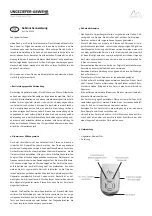
Connecting the sensor
R&S NRP-Z27/-Z37
1169.3870.12
1.6
E-6
PC control
Hardware and software requirements
The following requirements must be met if the power sensor is to be controlled by a PC via an interface
adapter:
The PC must have a USB port.
Either Microsoft Windows XP (32 Bit), Microsoft Windows Vista (32 or 64 Bit), Microsoft Windows 7
(32 or 64 Bit), or x86 Linux (with kernel 2.6.8 oder more recent) must be installed as the operating
system of the PC. 64-bit versions of Microsoft Windows XP are not supported. Operation with older
versions of Microsoft Windows with USB support (especially Microsoft Windows 2000) is normally
possible but cannot be guaranteed.
The USB device drivers in the supplied
NRP Toolkit
software package must be installed.
If these requirements are met, the power sensor can be controlled using a suitable application program
such as the
NrpFlashup
program contained in the Microsoft Windows version of the
NRP Toolkit
(includes the modules
Power Viewer
,
USB Terminal
,
Firmware Update
and
Update S-Parameters
).
When you insert the CD-ROM supplied with the R&S NRP, the
NRP Toolkit
is automatically installed on
your PC. The rest of the procedure is self-explanatory.
The power sensor can be powered in two ways:
Self-powered
from a separate power supply via the Active USB Adapter R&S NRP-Z3 or the
Sensor Hub R&S NRP-Z5.
Bus-powered
from the PC or a USB hub with its own power supply (
self-powered hub
) via the
Active USB Adapter R&S NRP-Z3 or via the Passive USB Adapter R&S NRP-Z4.
Because the power sensor R&S NRP-Z27/-Z37 has a maximum current capacity of 100 mA and is
therefore classified as a low-power device, it can be supplied with current from any stationary PC,
laptop or notebook in the bus-powered mode.















































